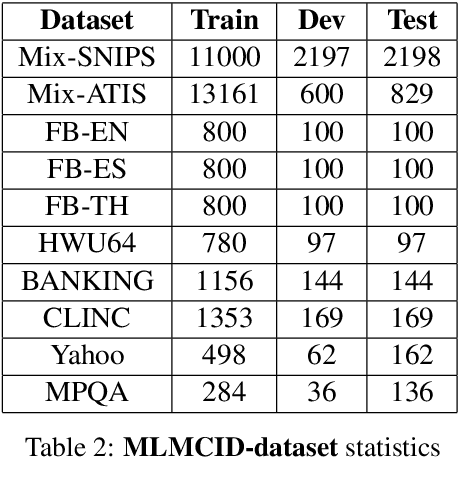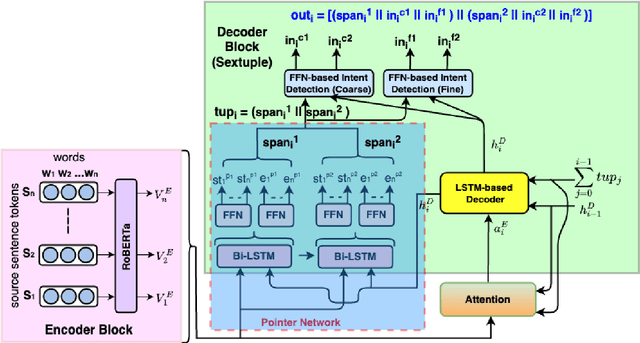Pawan Goyal
Indian Institute of Technology Kharagpur
Towards Blind and Low-Vision Accessibility of Lightweight VLMs and Custom LLM-Evals
Nov 13, 2025Abstract:Large Vision-Language Models (VLMs) excel at understanding and generating video descriptions but their high memory, computation, and deployment demands hinder practical use particularly for blind and low-vision (BLV) users who depend on detailed, context-aware descriptions. To study the effect of model size on accessibility-focused description quality, we evaluate SmolVLM2 variants with 500M and 2.2B parameters across two diverse datasets: AVCaps (outdoor), and Charades (indoor). In this work, we introduce two novel evaluation frameworks specifically designed for BLV accessibility assessment: the Multi-Context BLV Framework evaluating spatial orientation, social interaction, action events, and ambience contexts; and the Navigational Assistance Framework focusing on mobility-critical information. Additionally, we conduct a systematic evaluation of four different prompt design strategies and deploy both models on a smartphone, evaluating FP32 and INT8 precision variants to assess real-world performance constraints on resource-limited mobile devices.
Still Not There: Can LLMs Outperform Smaller Task-Specific Seq2Seq Models on the Poetry-to-Prose Conversion Task?
Nov 11, 2025Abstract:Large Language Models (LLMs) are increasingly treated as universal, general-purpose solutions across NLP tasks, particularly in English. But does this assumption hold for low-resource, morphologically rich languages such as Sanskrit? We address this question by comparing instruction-tuned and in-context-prompted LLMs with smaller task-specific encoder-decoder models on the Sanskrit poetry-to-prose conversion task. This task is intrinsically challenging: Sanskrit verse exhibits free word order combined with rigid metrical constraints, and its conversion to canonical prose (anvaya) requires multi-step reasoning involving compound segmentation, dependency resolution, and syntactic linearisation. This makes it an ideal testbed to evaluate whether LLMs can surpass specialised models. For LLMs, we apply instruction fine-tuning on general-purpose models and design in-context learning templates grounded in Paninian grammar and classical commentary heuristics. For task-specific modelling, we fully fine-tune a ByT5-Sanskrit Seq2Seq model. Our experiments show that domain-specific fine-tuning of ByT5-Sanskrit significantly outperforms all instruction-driven LLM approaches. Human evaluation strongly corroborates this result, with scores exhibiting high correlation with Kendall's Tau scores. Additionally, our prompting strategies provide an alternative to fine-tuning when domain-specific verse corpora are unavailable, and the task-specific Seq2Seq model demonstrates robust generalisation on out-of-domain evaluations.
IDALC: A Semi-Supervised Framework for Intent Detection and Active Learning based Correction
Nov 08, 2025



Abstract:Voice-controlled dialog systems have become immensely popular due to their ability to perform a wide range of actions in response to diverse user queries. These agents possess a predefined set of skills or intents to fulfill specific user tasks. But every system has its own limitations. There are instances where, even for known intents, if any model exhibits low confidence, it results in rejection of utterances that necessitate manual annotation. Additionally, as time progresses, there may be a need to retrain these agents with new intents from the system-rejected queries to carry out additional tasks. Labeling all these emerging intents and rejected utterances over time is impractical, thus calling for an efficient mechanism to reduce annotation costs. In this paper, we introduce IDALC (Intent Detection and Active Learning based Correction), a semi-supervised framework designed to detect user intents and rectify system-rejected utterances while minimizing the need for human annotation. Empirical findings on various benchmark datasets demonstrate that our system surpasses baseline methods, achieving a 5-10% higher accuracy and a 4-8% improvement in macro-F1. Remarkably, we maintain the overall annotation cost at just 6-10% of the unlabelled data available to the system. The overall framework of IDALC is shown in Fig. 1
* Paper accepted in IEEE Transactions on Artificial Intelligence (October 2025)
LLM Meets Diffusion: A Hybrid Framework for Crystal Material Generation
Oct 27, 2025Abstract:Recent advances in generative modeling have shown significant promise in designing novel periodic crystal structures. Existing approaches typically rely on either large language models (LLMs) or equivariant denoising models, each with complementary strengths: LLMs excel at handling discrete atomic types but often struggle with continuous features such as atomic positions and lattice parameters, while denoising models are effective at modeling continuous variables but encounter difficulties in generating accurate atomic compositions. To bridge this gap, we propose CrysLLMGen, a hybrid framework that integrates an LLM with a diffusion model to leverage their complementary strengths for crystal material generation. During sampling, CrysLLMGen first employs a fine-tuned LLM to produce an intermediate representation of atom types, atomic coordinates, and lattice structure. While retaining the predicted atom types, it passes the atomic coordinates and lattice structure to a pre-trained equivariant diffusion model for refinement. Our framework outperforms state-of-the-art generative models across several benchmark tasks and datasets. Specifically, CrysLLMGen not only achieves a balanced performance in terms of structural and compositional validity but also generates more stable and novel materials compared to LLM-based and denoisingbased models Furthermore, CrysLLMGen exhibits strong conditional generation capabilities, effectively producing materials that satisfy user-defined constraints. Code is available at https://github.com/kdmsit/crysllmgen
Label-semantics Aware Generative Approach for Domain-Agnostic Multilabel Classification
Jun 07, 2025



Abstract:The explosion of textual data has made manual document classification increasingly challenging. To address this, we introduce a robust, efficient domain-agnostic generative model framework for multi-label text classification. Instead of treating labels as mere atomic symbols, our approach utilizes predefined label descriptions and is trained to generate these descriptions based on the input text. During inference, the generated descriptions are matched to the pre-defined labels using a finetuned sentence transformer. We integrate this with a dual-objective loss function, combining cross-entropy loss and cosine similarity of the generated sentences with the predefined target descriptions, ensuring both semantic alignment and accuracy. Our proposed model LAGAMC stands out for its parameter efficiency and versatility across diverse datasets, making it well-suited for practical applications. We demonstrate the effectiveness of our proposed model by achieving new state-of-the-art performances across all evaluated datasets, surpassing several strong baselines. We achieve improvements of 13.94% in Micro-F1 and 24.85% in Macro-F1 compared to the closest baseline across all datasets.
Anveshana: A New Benchmark Dataset for Cross-Lingual Information Retrieval On English Queries and Sanskrit Documents
May 26, 2025Abstract:The study presents a comprehensive benchmark for retrieving Sanskrit documents using English queries, focusing on the chapters of the Srimadbhagavatam. It employs a tripartite approach: Direct Retrieval (DR), Translation-based Retrieval (DT), and Query Translation (QT), utilizing shared embedding spaces and advanced translation methods to enhance retrieval systems in a RAG framework. The study fine-tunes state-of-the-art models for Sanskrit's linguistic nuances, evaluating models such as BM25, REPLUG, mDPR, ColBERT, Contriever, and GPT-2. It adapts summarization techniques for Sanskrit documents to improve QA processing. Evaluation shows DT methods outperform DR and QT in handling the cross-lingual challenges of ancient texts, improving accessibility and understanding. A dataset of 3,400 English-Sanskrit query-document pairs underpins the study, aiming to preserve Sanskrit scriptures and share their philosophical importance widely. Our dataset is publicly available at https://huggingface.co/datasets/manojbalaji1/anveshana
REFINE-AF: A Task-Agnostic Framework to Align Language Models via Self-Generated Instructions using Reinforcement Learning from Automated Feedback
May 10, 2025Abstract:Instruction-based Large Language Models (LLMs) have proven effective in numerous few-shot or zero-shot Natural Language Processing (NLP) tasks. However, creating human-annotated instruction data is time-consuming, expensive, and often limited in quantity and task diversity. Previous research endeavors have attempted to address this challenge by proposing frameworks capable of generating instructions in a semi-automated and task-agnostic manner directly from the model itself. Many of these efforts have relied on large API-only parameter-based models such as GPT-3.5 (175B), which are expensive, and subject to limits on a number of queries. This paper explores the performance of three open-source small LLMs such as LLaMA 2-7B, LLama 2-13B, and Mistral 7B, using a semi-automated framework, thereby reducing human intervention, effort, and cost required to generate an instruction dataset for fine-tuning LLMs. Furthermore, we demonstrate that incorporating a Reinforcement Learning (RL) based training algorithm into this LLMs-based framework leads to further enhancements. Our evaluation of the dataset reveals that these RL-based frameworks achieve a substantial improvements in 63-66% of the tasks compared to previous approaches.
A Pointer Network-based Approach for Joint Extraction and Detection of Multi-Label Multi-Class Intents
Oct 29, 2024



Abstract:In task-oriented dialogue systems, intent detection is crucial for interpreting user queries and providing appropriate responses. Existing research primarily addresses simple queries with a single intent, lacking effective systems for handling complex queries with multiple intents and extracting different intent spans. Additionally, there is a notable absence of multilingual, multi-intent datasets. This study addresses three critical tasks: extracting multiple intent spans from queries, detecting multiple intents, and developing a multi-lingual multi-label intent dataset. We introduce a novel multi-label multi-class intent detection dataset (MLMCID-dataset) curated from existing benchmark datasets. We also propose a pointer network-based architecture (MLMCID) to extract intent spans and detect multiple intents with coarse and fine-grained labels in the form of sextuplets. Comprehensive analysis demonstrates the superiority of our pointer network-based system over baseline approaches in terms of accuracy and F1-score across various datasets.
CSSL: Contrastive Self-Supervised Learning for Dependency Parsing on Relatively Free Word Ordered and Morphologically Rich Low Resource Languages
Oct 09, 2024



Abstract:Neural dependency parsing has achieved remarkable performance for low resource morphologically rich languages. It has also been well-studied that morphologically rich languages exhibit relatively free word order. This prompts a fundamental investigation: Is there a way to enhance dependency parsing performance, making the model robust to word order variations utilizing the relatively free word order nature of morphologically rich languages? In this work, we examine the robustness of graph-based parsing architectures on 7 relatively free word order languages. We focus on scrutinizing essential modifications such as data augmentation and the removal of position encoding required to adapt these architectures accordingly. To this end, we propose a contrastive self-supervised learning method to make the model robust to word order variations. Furthermore, our proposed modification demonstrates a substantial average gain of 3.03/2.95 points in 7 relatively free word order languages, as measured by the UAS/LAS Score metric when compared to the best performing baseline.
ERVQA: A Dataset to Benchmark the Readiness of Large Vision Language Models in Hospital Environments
Oct 08, 2024Abstract:The global shortage of healthcare workers has demanded the development of smart healthcare assistants, which can help monitor and alert healthcare workers when necessary. We examine the healthcare knowledge of existing Large Vision Language Models (LVLMs) via the Visual Question Answering (VQA) task in hospital settings through expert annotated open-ended questions. We introduce the Emergency Room Visual Question Answering (ERVQA) dataset, consisting of <image, question, answer> triplets covering diverse emergency room scenarios, a seminal benchmark for LVLMs. By developing a detailed error taxonomy and analyzing answer trends, we reveal the nuanced nature of the task. We benchmark state-of-the-art open-source and closed LVLMs using traditional and adapted VQA metrics: Entailment Score and CLIPScore Confidence. Analyzing errors across models, we infer trends based on properties like decoder type, model size, and in-context examples. Our findings suggest the ERVQA dataset presents a highly complex task, highlighting the need for specialized, domain-specific solutions.
 Add to Chrome
Add to Chrome Add to Firefox
Add to Firefox Add to Edge
Add to Edge